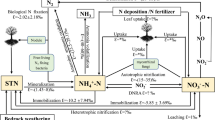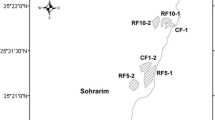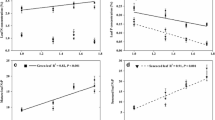Abstract
Background and aims
Understanding changes in soil N cycling with stand development is critical for forest management as tree growth is affected by soil N availability. The aim of this study was to evaluate the changes in soil N availability and loss with stand development in trembling aspen (Populus tremuloides Michx.) and jack pine (Pinus banksiana Lamb.) in northeastern Alberta, Canada.
Methods
Soil inorganic N availability (measured as N supply rate) and foliar N chemistry (N concentration and δ15N) in trembling aspen stands ranged from 52 to 70 years old (n = 7) and jack pine stands 43 to 78 years old (n = 8) were investigated in 2008 and 2009. The relationships among the ratios of NO3 --N to total inorganic N (NO3 --N/TIN), foliar N concentration, and foliar δ15N with stand age were also explored by regression analyses.
Results
Total inorganic N supply rates did not systematically change with stand age across stand types, soil layers and measurement periods; whereas NO3 --N/TIN showed a decreasing tendency with stand age, suggesting that nitrification and associated N loss potential became smaller in older stands with greater limitation in soil N availability. Foliar δ15N decreased with stand age from −1.7 to −4.7‰ for aspen and from −4.1 to −7.1‰ for jack pine, and there were positive correlations between foliar δ15N and soil NO3 --N/TIN, suggesting that decreased soil N loss led to less 15N-depletion in the inorganic N available for tree uptake in older stands. However, foliar N concentration did not significantly change with stand age, suggesting that there were other N sources such as organic N in the forest floor, in addition to the inorganic N, available for plant uptake.
Conclusions
Our results suggest that soil inorganic N availability became more limited as stand age increased. In addition, the ratio of NO3 --N/TIN and its relationship with foliar δ15N indicated decreased soil N loss potential and shifted N sources with stand age in boreal forests that are typically N-limited. Our study demonstrated that declining nitrification with increasing stand age might be one of the mechanisms mediating N-limitation in the studied boreal forests.



Similar content being viewed by others
References
Aubert M, Bureau F, Vinceslas-Akpa M (2005) Sources of spatial and temporal variability of inorganic nitrogen in pure and mixed deciduous temperate forests. Soil Biol Biochem 37:67–79
Binkley D, Son Y, Valentine DW (2000) Do forests receive occult inputs of nitrogen? Ecosystems 3:321–331
Chang SX, Handley LL (2000) Site history affects soil and plant 15N natural abundances (δ15N) in forests of northern Vancouver Island, British Columbia. Funct Ecol 14:273–280
Choi WJ, Ro HM, Lee SM (2003) Natural 15N abundances of inorganic nitrogen in soil treated with fertilizer and compost under changing soil moisture regimes. Soil Biol Biochem 35:1289–1298
Choi WJ, Chang SX, Allen HL, Kelting DL, Ro HM (2005a) Irrigation and fertilization effects on foliar and soil carbon and nitrogen isotope ratios in a loblolly pine stand. For Ecol Manage 213:90–101
Choi WJ, Chang SX, Hao X (2005b) Soil retention, tree uptake, and tree resorption of 15NH4NO3 and NH4 15NO3 applied to trembling and hybrid aspens at planting. Can J For Res 35:823–831
Choi WJ, Lee SM, Chang SX, Ro HM (2005c) Variations of δ13C and δ15N in Pinus densiflora tree- rings and their relationship to environmental changes in eastern Korea. Water, Air, Soil Pollut 164:173–187
Choi WJ, Chang SX, Bhatti JS (2007) Drainage affects tree growth and C and N dynamics in a minerotrophic peatland. Ecology 88:443–453
Compton JE, Hooker TD, Perakis SS (2007) Ecosystem N distribution and during a century of forest regrowth after agricultural abandonment. Ecosystems 10:1197–1208
Craine JM, Elmore AJ, Aidar MP, Bustamante M, Dawson TE, Hobbie EA, Kahmen A, Mack MC, McLauchlan KK, Michelsen A, Nardoto GB, Pardo LH, Peñuelas J, Reich PB, Schuur EA, Stock WD, Templer PH, Virginia RA, Welker JM, Wright IJ (2009) Global patterns of foliar nitrogen isotopes and their relationships with climate, mycorrhizal fungi, foliar nutrient concentrations, and nitrogen availability. New Phytol 183:980–992
DeLuca TH, Nilsson MC, Zackrisson O (2002) Nitrogen mineralization and phenol accumulation along a fire chronosequence in northern Sweden. Oecologia 133:206–214
Driscoll KG, Arocena JM, Massicotte HB (1999) Post-fire soil nitrogen content and vegetation composition in Sub-Boreal spruce forests of British Columbia’s central interior, Canada. For Ecol Manage 121:227–237
Evans RD (2001) Physiological mechanisms influencing plant nitrogen isotope composition. Trends Plant Sci 6:121–126
Fang HJ, Yu GR, Cheng SL, Zhu TH, Zheng JJ, Mo JM, Yan JH, Luo YQ (2011) Nitrogen-15 signals of leaf-litter-soil continuum as a possible indicator of ecosystem nitrogen saturation by forest succession and N loads. Biogeochemistry 102:251–263
Garten CT, Iversen CM, Norby RJ (2011) Litterfall 15N abundance indicates declining soil nitrogen availability in a free-air CO2 enrichment experiment. Ecology 92:133–139
Goodale CL, Aber JD, Vitousek PM, McDowell WH (2003) Long-term decreases in stream nitrate: successional causes unlikely; possible links to DOC? Ecosystems 8:334–337
Gundersen P, Sevel L, Christiansen JR, Vesterdal L, Hansen K, Bastrup-Birk A (2009) Do indicators of nitrogen retention and leaching differ between coniferous and broadleaved forests in Denmark? For Ecol Manage 258:1137–1146
Hietz P, Turner BL, Wanek W, Richter A, Nock CA, Wright SJ (2011) Long-term change in the nitrogen cycle of tropical forests. Science 334:664–666
Hobbie EA, Macko SA, Williams M (2000) Correlations between foliar δ15N and nitrogen concentrations may indicate plant-mycorrhizal interactions. Oecologia 122:273–283
Högberg P, Johannisson C (1993) 15N abundance of forests is correlated with losses of nitrogen. Plant Soil 157:147–150
Kahmen A, Wanek W, Buchmann N (2008) Foliar values characterize soil N cycling and reflect nitrate or ammonium preference of plants along a temperate grassland gradient. Oecologia 156:861–870
Kielland K, Olson K, Ruess RW, Boone RD (2006) Contribution of winter processes to soil nitrogen flux in taiga forest ecosystems. Biogeochemistry 81:349–360
Koba K, Tokuchi N, Yoshioka T, Hobbie EA, Iwatsubo G (1998) Natural abundance of 15N in a forest soil. Soil Sci Soc Am J 62:778–781
Kwak JH, Choi WJ, Lim SS, Arshad MA (2009) δ13C, δ15N, N concentration, and Ca-to-Al ratios of forest samples from Pinus densiflora stands in rural and industrial areas. Chem Geol 264:385–393
LeDuc SD, Rothstein DE (2010) Plant-available organic and mineral nitrogen shift in dominance with forest stand age. Ecology 91:708–720
LeDuc SD, Rothstein DE, Yermakow Z, Spaulding SE (2013) Jack pine foliar δ15N indicates shifts in plant nitrogen acquisition after severe wildfire and through forest stand development. Plant Soil. doi:10.1007/s11104-013-1856-0
Makarov MI (2009) The nitrogen isotopic composition in soils and plants: its use in environmental studies (a review). Eurasian Soil Sci 42:1335–1347
Matsushima M, Choi WJ, Chang SX (2012) White spruce foliar δ13C and δ15N indicate changed soil N availability by understory removal and N fertilization in a 13-year-old boreal plantation. Plant Soil 361:375–384
Mayor JR, Schuur EAG, Mack MC, Hollingsworth TN, Bååth E (2012) Nitrogen isotope patterns in Alaskan black spruce reflect organic nitrogen sources and the activity of ectomycorrhizal fungi. Ecosystems 15:819–831
McLauchlan KK, Craine JM, Oswald WW, Leavitt PR, Likens GE (2007) Changes in nitrogen cycling during the past century in a northern hardwood forest. Proc Natl Acad Sci U S A 104:7466–7470
Moore TR, Trofymow JA, Taylor B, Prescott C, Camiré C, Duschene L, Fyles J, Kozak L, Kranabetter M, Morrison I, Sitanen M, Smith S, Titus B, Visser S, Wein R, Zoltai S (1999) Litter decomposition rates in Canadian forests. Global Change Biol 5:75–82
Nadelhoffer K, Shaver G, Fry B, Giblin A, Johnson L, McKane R (1996) 15N natural abundances and N use by tundra plants. Oecologia 107:386–394
Odum EP (1969) The strategy of ecosystem development. Science 164:262–270
Olson R, Reiners W (1983) Nitrification in subalpine balsam fir soils: tests for inhibitory factors. Soil Biol Biochem 15:413–418
Pardo LH, Templer PH, Goodale CL, Duke S, Groffman PM, Adams MB, Boeckx P, Boggs J, Campbell J, Colman B, Compton J, Emmett B, Gundersen P, Kjonaas J, Lovett G, Mack M, Magill A, Mbila M, Mitchell MG, McGeee G, McNulty S, Nadelhoffer K, Ollinger S, Ross D, Schleppi P, Spoelstra J, Wessel W (2006) Regional assessment of N saturation using foliar and root δ15N. Biogeochemistry 80:143–171
Pardo LH, Semaoune P, Schaberg PG, Eagar C, Sebilo M (2013) Patterns in δ15N in roots, stems, and leaves of sugar maple and American beech seedlings, saplings, and mature trees. Biogeochemistry 112:275–291
Prasolova NV, Xu ZH, Saffigna PG, Dieters MJ (2000) Spatial-temporal variability of soil moisture, nitrogen availability indices and other chemical properties in hoop pine (Araucaria cunninghamii) plantations of subtropical Australia. For Ecol Manage 136:1–10
Rice EL, Pancholy SK (1972) Inhibition of nitrification by climax ecosystems. Am J Bot 59:1033–1040
Soil Classification Working Group (1998) The Canadian system of soil classification, 3rd edn. NRC Research Press, Ottawa
Stark JM, Hart SC (1997) High rates of nitrification and nitrate turnover in undisturbed coniferous forests. Nature 385:61–64
Ste-Marie C, Paré D, Gagnon D (2007) The contrasting effects of aspen and jack pine on soil nutritional properties depend on parent material. Ecosystems 10:1299–1310
Vance ED, Chapin FS III (2001) Substrate limitations to microbial activity in taiga forest floors. Soil Biol Biochem 33:173–188
Vitousek PM, Reiners WA (1975) Ecosystem succession and nutrient retention: a hypothesis. BioScience 25:376–381
Vitousek PM, Matson PA, Van Cleve K (1989) Nitrogen availability and nitrification during succession: primary, secondary, and old-field seres. Plant Soil 115:229–239
Yan ER, Hu YL, Salifu F, Tan X, Chen ZC, Chang SX (2012) Effectiveness of soil N availability indices in predicting site productivity in the oil sands region of Alberta. Plant Soil 359:215–231
Yermakov Z, Rothstein DE (2006) Changes in soil carbon and nitrogen cycling along a 72-year wildfire chronosequence in Michigan jack pine forests. Oecologia 149:690–700
Acknowledgements
This study was financially supported by the Cumulative Environmental Management Association (CEMA) in Alberta, Shell Canada Energy, the Alberta Energy Environment Technology Fund, the Oil Sands Research and Information Network (OSRIN), and Alberta Environment and Sustainable Resource Development. We are grateful to Raza Purvez, Yue Hu, Pak Chow, Xin Zhang, Fengping Wu, and Shanghua Sun for their considerable help in the field work and laboratory analyses. We also thank two anonymous reviewers and Dr. Yong-Fu Li for their helpful comments that substantially improved an earlier version of this manuscript.
Author information
Authors and Affiliations
Corresponding authors
Additional information
Responsible Editor: Zucong Cai.
Rights and permissions
About this article
Cite this article
Hu, YL., Yan, ER., Choi, WJ. et al. Soil nitrification and foliar δ15N declined with stand age in trembling aspen and jack pine forests in northern Alberta, Canada. Plant Soil 376, 399–409 (2014). https://doi.org/10.1007/s11104-013-1994-4
Received:
Accepted:
Published:
Issue Date:
DOI: https://doi.org/10.1007/s11104-013-1994-4




